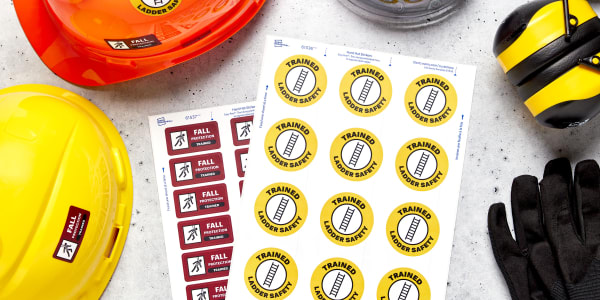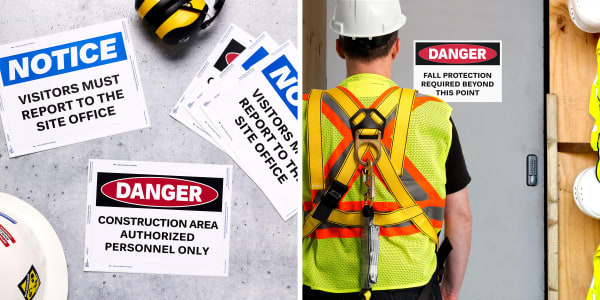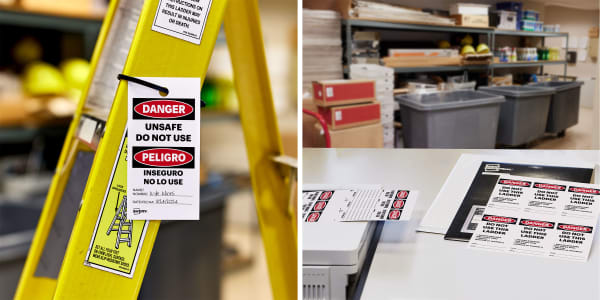Keep workers safe and avoid OSHA violations
Are the top 10 construction safety rules a no-brainer, or will some of them surprise you? Whether you’ve been at it for decades or are new to the profession, knowing and following them is essential. Not only do these rules keep everyone that crosses your site safe, but they also save you money. In truth, ignoring safety rules can often lead to expensive OSHA violations. Here is a simple list of the top 10 most important construction safety rules, which we will cover in more depth below.
- Wear required PPE
- Set up safeguards
- Use safety signs
- Provide clear instructions
- Be prepared for emergencies
- Keep your site tidy
- Use the right tool for the job
- Inspect tools and equipment
- Put away and organize tools
- Report safety concerns
More articles you might like
- Safety Signs Decoded: Who Makes the Rules (OSHA vs. ANSI)?
- Label it Right: 4 Quick Tips for Safer Secondary Containers
- 7 Easy Ways to Organize Warehouse Storage
What is construction safety management?
Construction safety management is a system of procedures that take a proactive approach to identifying and managing hazards on a jobsite. It is a systematic way of preventing accidents by identifying potential hazards, assessing the risks associated with them, and implementing controls to reduce or eliminate those risks. Using a construction safety management system can help you protect workers, keep a job site running smoothly, and save money by avoiding costly safety violations.

1) Wear required PPE at all times
“Helping our team understand why and when to use PPE has helped us reduce incidents on the job site,” says Luis Sanchez of Cherry Coatings, a commercial coating company.
PPE is essential in construction to protect workers from hazards like chemicals, airborne particles, falls, and flying objects. Founder of Mr. Kitchen Faucets, Matt Hagens, recalls safety goggles protecting his eyes from debris, noting, “That experience taught me that accidents can happen in a split second, but PPE provides a crucial shield against injuries.”
How to ID PPE for construction safety
Wearing PPE is one of the most crucial construction safety measures, making it essential to keep track of this equipment effectively. Whether you’re an employee managing your own PPE or a safety officer overseeing company-owned items, using the right labels and tags is key. Simple paper labels aren’t suitable for the harsh conditions of construction sites, as they won’t last and could pose safety risks if equipment isn’t identifiable. For robust labeling, consider hard hat stickers, durable labels, and asset tags, which are designed to withstand the demanding environment of a construction site.
Additionally, tracking company-owned PPE offers other benefits, such as managing expensive gear and helping safety officers meet compliance standards. Avery PermaTrack® asset tag labels 61520 are highly recommended for this purpose because they are waterproof and resistant to chemicals and abrasion. Moreover, these tags can be customized online with barcodes and printed on a standard laser printer. For identifying employee-owned PPE, vinyl hard hat stickers and labels are ideal. These products are waterproof, resistant to chemicals and abrasion, and can withstand UV fading for up to two years. Both PermaTrack asset tags and Avery hard hat stickers can be customized for free using Avery Design and Print Online (ADPO) software, making them convenient and reliable solutions for PPE management.
2) Set up safeguards to keep people away from hazards
“People will walk anywhere without awareness of their surroundings; signs and barriers reduce injury risk,” says Tom Wilkerson, CEO of CertifyMe.net.
Physical barriers like guardrails, fall protection, hole covers, and fencing are essential to keep people away from hazards on construction sites. Terry Dussault, CEO of Yellowknife Consulting Services, highlights their importance by recounting an incident where a loose air hose struck a woman at a bus stop, emphasizing the need for proper safeguards.

3) Use safety signs to guide workers and visitors
Using safety signs is one of the simplest construction rules to follow, thanks to the availability of resources for making signs quickly onsite. The benefits include preventing accidents, injuries, and liability claims. Mike Grijavalva, owner of Sacramento Plumbing Solutions, notes that proper signage significantly reduces the risk of accidents, like workers and pedestrians falling into poorly marked openings.
In any case, safety signs for construction sites are very easy to make with four simple tools. 1) A laptop or tablet that’s connected to the internet and a printer; 2) A laser or inkjet printer; 3) Printable Avery Industrial safety signs; and 4) Our free ADPO software.
4) Provide clear instructions and training
“If I haven’t given clear instructions and training to a team member and they make a mistake, it’s not their fault; it’s mine,” says Grijavalva. That’s because employers must provide a safe work environment, as required by OSHA. Training employees and giving clear instructions are key preventative measures. Even if an employee has previous training, it may not be sufficient for your specific work site.
To ensure safety, ensure all employees complete OSHA-mandated training, keep an induction binder accessible for new workers, and conduct daily “toolbox talks” to relay safety instructions and gather worker signatures. These talks also allow workers to report issues. General contractor Matt Hagens says well-informed workers are more confident, productive, and contribute positively to a safety culture.
5) Be prepared for emergencies with an accessible plan
Taking a few extra moments to decide on emergency actions can be lifesaving, making it crucial to have a clear emergency plan for natural disasters, fires, hazardous material spills, and other incidents. Educating workers on these plans is essential, even if there’s a dedicated emergency response team.
“We have printed instructions in English and Spanish at our job site’s base of operations so everyone knows what to do in an emergency—not just foremen or field managers,” says Luis Sanchez of Cherry Coatings. This approach ensures all employees have access to emergency plans. For durability, store these plans in an Avery 79693 heavy-duty binder, which is ideal for emergency plans, site induction materials, and safety rules. Its reinforced edges and clear front make it both durable and easily identifiable.
6) Keep your site tidy using lean skills
“Proper housekeeping prevents worker injuries like slips, trips, and falls,” says Terry Dussault, CEO of Yellowknife Consulting Services.
Lean skills, like 5S/6S (Sort, Set in Order, Shine, Standardize, Sustain, and Safety), enhance construction safety by reducing clutter, keeping pathways clean, and encouraging regular tool maintenance. Forklift certification expert Wilkerson adds, “It’s easy for someone to trip and fall with all the materials usually found in these environments.” Additionally, Wilkerson notes, “A clean worksite exudes professionalism and helps build a good reputation.”
You can review lean skills with our simple 5S/6S reference list.
7) Use the right tool for the job
Using the wrong tool can lead to injuries, both to the user and to others on the construction site. Meanwhile, using the right tool not only helps you avoid injuries but also achieve a more accurate result, work more efficiently, and produce a higher-quality product. So in the long run, using the right tool for the job saves you money upfront as well as helping you avoid hidden costs. For example, you can avoid lost productivity and efficiency caused by injuries, as well as money lost due to a poor reputation.
While the money-saving benefits are certainly a plus, safety on the construction site must always be the priority. In fact, Hagens says, “I remember one incident where a worker tried to unscrew a high-torque bolt using a standard wrench. It slipped, causing a nasty hand injury. It was a sobering reminder that the right tools are essential for every job, no matter how big or small.”

8) Inspect tools and equipment before use
Some equipment must be inspected before use by law; for instance, ladders, which we’ve discussed before. However, it’s still considered best practice to always inspect all tools and equipment before using them. This is a basic yet important construction safety rule to follow in order to keep workers safe. Sanchez from Cherry Coatings explains that in his industry, “Spray rig or joint pump clogs, leaks, electrical malfunctions, and respirator damage are just some of the potential hazards that can cause incidents if left unchecked.”
9) Put away and organize tools
Keeping your construction site organized prevents injuries! Tools left lying around create trip hazards and electrical dangers and can be knocked over or dropped. When tools are neatly stored, they’re easier to find, preventing workers from using the wrong equipment for the job. Safety consultant Dussault emphasizes the importance of keeping tools organized to avoid getting hurt by sharp edges or missing potential wear and tear issues. By taking a few minutes to put tools away after use, you can significantly reduce the risk of accidents on your site.
10) Report safety concerns right away
Don’t let small problems turn into big emergencies! Encourage open communication about safety concerns on your construction site. Regularly hold toolbox talks where workers can report issues, and consider setting up a dedicated “safety mailbox” for anonymous reporting. Mike Hagens, founder of Mr. Kitchen Faucets, emphasizes, “Hiding an issue is a recipe for disaster.” By making workers feel comfortable reporting concerns, you can address problems before they become serious accidents. Remember, early detection is key to keeping everyone safe!
Who is responsible for construction site safety?
Construction site safety is the responsibility of construction companies. They must follow OSHA standards and take steps to prevent accidents, such as requiring PPE and using safeguards. This helps to keep workers safe and saves money in the long run.
That being said, construction site safety is strengthened when everyone pitches in. General contractors, project managers, foremen, subcontractors, and all employees on a site keep each other safe by following basic construction safety rules.
How many construction safety rules do you know and follow?
We’ve highlighted the top 10 construction safety rules critical for worker safety:
- Wear the required PPE at all times.
- Implement safeguards to prevent hazards.
- Use safety signs for guidance.
- Provide clear instructions.
- Be ready for emergencies.
- Maintain a tidy work site.
- Use appropriate tools.
- Regularly inspect tools and equipment.
- Organize tools properly.
- Report safety concerns promptly.
Adhering to these rules is paramount as they reduce accidents, benefiting both workers and employers by averting costly injuries. Additionally, we provided useful advice on creating PPE asset tags, durable ID labels, hard hat stickers, signs, and inspection tags at your site. Simplify safety communication with our free Avery Design and Print Online (ADPO) software and templates- why not get started now?
Please note, the contents of this article and related articles on avery.com are for informational purposes only, are general in nature, and are not intended to and should not be relied upon or construed as a legal opinion or legal advice regarding any specific issue or factual circumstance.




